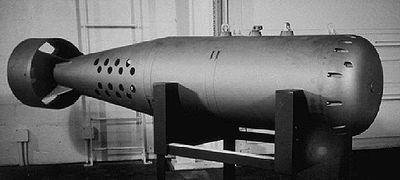
Mk-101 Lulu NDB (Nuclear Depth Bomb)
Encyclopedia

Nuclear Depth Bomb
A Nuclear Depth Bomb is the nuclear equivalent of the conventional depth charge and can be used in Anti-Submarine Warfare for attacking submerged submarines...
(NDB) developed by the United States
United States
The United States of America is a federal constitutional republic comprising fifty states and a federal district...
in the 1950s. It utilized a W34 nuclear warhead, with a yield of about 11 kilotons. It was deployed by the United States Navy
United States Navy
The United States Navy is the naval warfare service branch of the United States Armed Forces and one of the seven uniformed services of the United States. The U.S. Navy is the largest in the world; its battle fleet tonnage is greater than that of the next 13 largest navies combined. The U.S...
for the purposes of anti-submarine warfare
Anti-submarine warfare
Anti-submarine warfare is a branch of naval warfare that uses surface warships, aircraft, or other submarines to find, track and deter, damage or destroy enemy submarines....
, in five different models, from 1958 until 1971. Weapons were also stockpiled at overseas allied bases under American military guard for use by maritime aircraft of NATO allies, notably at RAF St. Mawgan
RAF St. Mawgan
RAF St Mawgan is a Royal Air Force station near St Mawgan and Newquay in Cornwall. In 2008 the runway part of the site was handed over to Newquay Airport. The remainder of the station still continues to operate under the command of the RAF...
, Cornwall
Cornwall
Cornwall is a unitary authority and ceremonial county of England, within the United Kingdom. It is bordered to the north and west by the Celtic Sea, to the south by the English Channel, and to the east by the county of Devon, over the River Tamar. Cornwall has a population of , and covers an area of...
, for use by Royal Air Force
Royal Air Force
The Royal Air Force is the aerial warfare service branch of the British Armed Forces. Formed on 1 April 1918, it is the oldest independent air force in the world...
Avro Shackleton
Avro Shackleton
The Avro Shackleton was a British long-range maritime patrol aircraft for use by the Royal Air Force. It was developed by Avro from the Avro Lincoln bomber with a new fuselage...
aircraft, and the Dutch Navy P-2 Neptune
P-2 Neptune
The Lockheed P-2 Neptune was a Maritime patrol and ASW aircraft. It was developed for the United States Navy by Lockheed to replace the Lockheed PV-1 Ventura and PV-2 Harpoon, and being replaced in turn with the Lockheed P-3 Orion...
and P-3 Orion
P-3 Orion
The Lockheed P-3 Orion is a four-engine turboprop anti-submarine and maritime surveillance aircraft developed for the United States Navy and introduced in the 1960s. Lockheed based it on the L-188 Electra commercial airliner. The aircraft is easily recognizable by its distinctive tail stinger or...
aircraft. The Mk-101 "Lulu" began to be replaced by the multi-purpose B57 nuclear bomb
B57 nuclear bomb
The B57 nuclear bomb was a tactical nuclear weapon developed by the United States during the Cold War.Entering production in 1963 as the Mk 57, the bomb was designed to be dropped from high-speed tactical aircraft. It had a streamlined casing to withstand supersonic flight. It was 3 m long, with a...
in the mid-1960s. The B-57 was a bomb that could be used by tactical strike aircraft in a land warfare role, as well as a nuclear depth bomb. The Mk-101 "Lulu" had a length of 7 ft 6 in, diameter of 1 ft 6 in, and weighed 1,200 lbs. In RAF service for carriage by Shackleton MR2 and MR3 maritime patrol bombers it was known as Bomb, AS, 1200 lb, MC.
This weapon lacked an important safety/arming device i.e. there were no sensors to detect free-fall from an aircraft which would result from the bomb being intentionally dropped in flight. As a result, if an armed Mk 101 bomb accidentally fell off an aircraft whilst it was parked on the flight deck
Flight deck
The flight deck of an aircraft carrier is the surface from which its aircraft take off and land, essentially a miniature airfield at sea. On smaller naval ships which do not have aviation as a primary mission, the landing area for helicopters and other VTOL aircraft is also referred to as the...
of a warship and then rolled overboard, it could automatically detonate when it sank to the preset depth..
The W34 boosted-fission warhead used in the Mk-101 "Lulu" was also used in several other similar weapons, and a version referred to as 'Peter' was used as a thermonuclear primary in the British Yellow Sun
Yellow Sun
Yellow Sun was the first British operational high-yield strategic nuclear weapon. The name actually refers only to the outer casing; the warhead was known as "Green Grass" and "Red Snow"...
and as the "Python" in the U.S. (The B28 nuclear bomb
B28 nuclear bomb
The B28, originally Mark 28, was a thermonuclear bomb carried by U.S. tactical fighter bombers and bomber aircraft. From 1962 to 1972 under the NATO nuclear weapons sharing program, American B28s also equipped six Europe-based Canadian CF-104 squadrons known as the RCAF Nuclear Strike Force...
).

